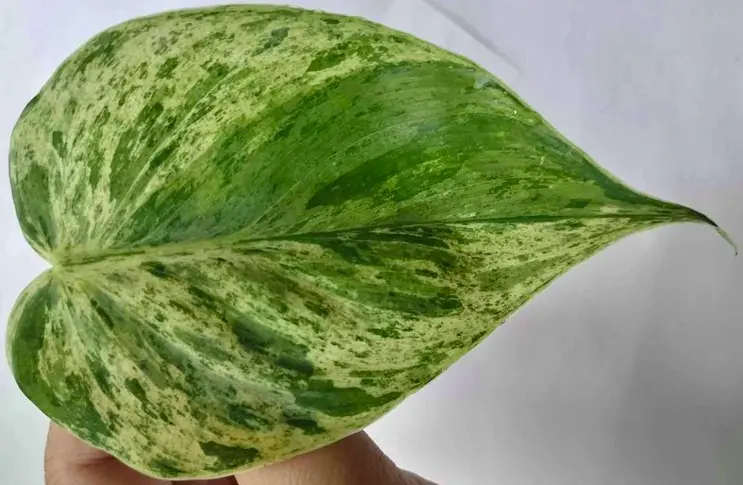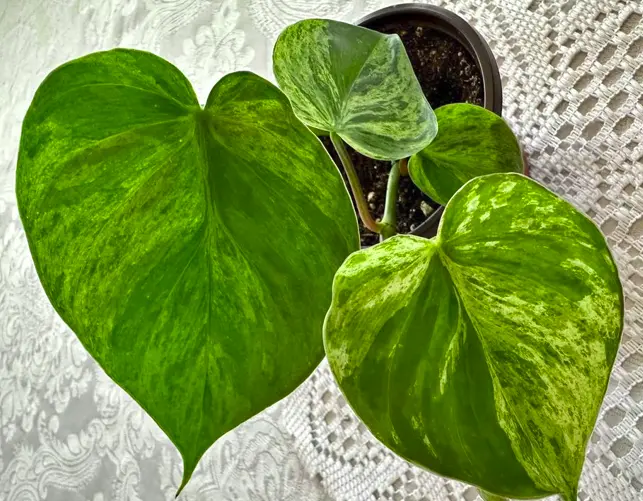A variegated heart leaf philodendron makes for an exciting addition to your home and is relatively easy to care for, as long as you have enough light. If you want to add some green to your indoor decor without having to water, then variegated heart leaf philodendrons are just what you need.
These plants can be attractive and easy to care for, but they require special attention to thrive indoors. Here are all you need to know about growing and caring for your variegated heart leaf philodendron, from watering it the right way through repotting it, so your plant will always look its best!
What is a Variegated Heart Leaf Philodendron?

A variegated heart leaf philodendron is a houseplant with leaves with a mixture of cream, yellow, green, and white stripes. They grow well in low-light situations, making them great for apartments. These plants are also easy to care for and can quickly propagate from cuttings.
This philodendron variety, with its trailing vines and heart-shaped leaves, is ideal for interior usage since it can filter gaseous contaminants from the air. The variegated heart leaf philodendron is a robust grower in suitable indoor conditions, trailing up to 10 feet long.
Tropical Habitat
The variegated heart leaf philodendron’s dark green trailing leaves always give its user a tropical forest vibe. Their native habitats are the West Indies, Mexico, and Brazil, which explains their tropical nature perfectly. They bloom seldom, but when they do, their exquisite beauty enhances the attractiveness of the entire area.
Hardiness Zones
The variegated heart leaf philodendron grows in the USDA hardiness zone level of 9-11. Notwithstanding their tropical nature, these plants can tolerate low humidity, and occasional misting keeps it resistant to dry conditions; yet, they can survive for days without water.
Features of the Variegated Heart Leaf Philodendron
Trailing nature
Variegated heart leaf philodendrons trail; depending on where you place them, they will hang below your window or climb up your bookshelf. If you want your plant to climb, attach the stems to a pole or other upright objects. These plants can quickly adapt to any environment, making them very user-friendly.
Toxicity
The variegated heart leaf philodendron’s leaves contain calcium oxalate crystals, which are toxic to pets and humans. It is dangerous to consume; hence keep your children and pets away from these plants. Its side effects include nausea, decreased appetite, and mouth swelling.
Foliage
The variegated heart leaf philodendron’s leaves genuinely grab the hearts of those who see them. Because of its variegation, the dark green tone with white spots adds to its attractiveness by providing an excellent contrast with the natural color of the leaf.
Size
The variegated heart leaf philodendron can grow to reach 20 feet tall in its natural habitat. They may grow past 4 feet in height under low light settings inside a house. Pinching it will make it full and bushy. Pinch the leaf away from the stem where it is attached, and it will sprout a new stem from that location, enabling your plant to grow with several stems.
Propagating a Variegated Heart Leaf Philodendron

Variegated heart leaf philodendrons are a type of plant with different foliage colors. These plants are easy to grow, and you can propagate them in soil or water using stem cuttings.
Propagating the Stem Cutting in Soil:
- Take the stem cutting from a healthy variegated heart leaf philodendron plant, making sure to use at least 3-inch stems.
- Trim off all leaves except for one or two.
- Fill a pot with moist soil and bury the stem about an inch deep, placing it in direct sunlight.
- Mist it regularly with water, so the soil remains moist but not too wet (to avoid fungus).
- Leave this in place until new growth appears on top of the buried stem—usually within 1-3 weeks.
- Once there is new growth, carefully remove the stem from the soil and plant it in another pot of soil.
- Water well and leave it alone until established, which usually takes 2-4 weeks, depending on conditions. You should continue propagating this way every six months if you want more variegated plants around your home.
Propagating the Stem Cutting in Water:
- Cut the stem and select a section with a node and new growth.
- Place the stem in a glass of water or a transparent container and keep an eye on the root development.
- Keep the cutting in a bright, sheltered place with adequate ventilation.
- To avoid bacterial disease, refill or replace the glass of water every 3-5 days.
- After two weeks of checking for progress and root growth, transplant the stem cutting; if the new roots are one inch or longer, place the stem cutting in a sterile potting mix.
Caring for the Variegated Heart Leaf Philodendron
The variegated heart leaf philodendron is a beautiful plant found in many gardens. It’s one of the easier houseplants to grow and doesn’t require special attention to thrive. However, there are some specific things you need to know about this type of philodendron that will help keep it healthy.
Soil
Using a pot about two inches bigger than the root ball. The pot must have drainage holes in the bottom to drain excess water. Fill the pot with peat moss, sand, and perlite. A good ratio is two parts peat moss, 1 part sand, and three parts perlite. This combination will provide good drainage while allowing your plant to hold enough moisture without being too wet.
Light
When it comes to light, keep your plant out of direct sunlight as too much sun can burn them and cause discoloration; however, make sure they are not kept away from windows either because indirect light isn’t enough for them to grow well without any sun at all.
Watering
You can only water your plant when the soil is arid, as overwatering can lead to root rot. Too little watering can also kill your plant, so knowing how much to give it is essential. If unsure, water it until a small amount comes from the pot’s drain hole at the bottom. The best option is to water your plants early or late in the evening rather than midday. This increases humidity levels in the home or office environment and could harm your heart leaf philodendron.
Fertilizing
A good, all-purpose fertilizer will work well for your variegated heart leaf philodendron. Fertilizers vary in the amount of nitrogen, phosphorous, and potassium they provide. The best time to fertilize is spring before new growth starts. Apply a layer of fertilizer around the plant’s base. If you have a pot with drainage holes in the bottom, pour water on top of the fertilizer to help it break down.
Repotting
As your variegated heart leaf philodendron grows, try transferring it to a larger pot if you notice roots pushing out the drainage holes. Because of its rapid growth, you should repot your plant every 2-3 years at best. Use fresh soil when repotting your variegated heart leaf philodendron to offer its roots more nutrients to eat.
pH Level
Your variegated heart leaf philodendron enjoys neutral to acidic soil, so keep the pH between 5.5 and 6.0. If you’re worried about acidity, you can evaluate your soil using an essential pH testing tool. Use aluminum sulfate or sulfur to control high pH levels in your soil. Add wood ash, dolomite lime, calcitic or baking soda to raise the pH level.
Aeration and Humidity
The variegated heart leaf philodendron is an uncommon perennial that thrives in extreme humidity. Hence, ensure an air humidity level of 50% to 70% for best outcomes. In addition to the water it takes via its roots, your plant will require sustenance from the moisture present in the air. You can make a pebble tray or have water basins nearby to evaporate. Getting in a humidifier that consistently improves humidity for your plant is also an excellent option.
Pruning
Long stems should be trimmed right after the leaf node, taking care not to damage the node. Pruning encourages the variegated heart leaf philodendron to develop a consistent form with several stems and more leaves.
Pests and Diseases
Pest can be a significant problem for any plant, but they pose a greater threat to variegated heart leaf philodendrons. Spider mites, aphids, mealybugs, and scale insects are some pests that may attack the plant.
To control these pests, purchase a safe insecticide for use around plants and apply it regularly. As mentioned earlier, if you notice new growth on your philodendron turning brown or yellow, you might have a pest infestation. Treating it will help prevent further damage to your plant’s leaves or roots.
The variegated heart leaf philodendron is a beautiful plant that can grow well in low-light areas. They’re easy to care for and make a lovely décor to any room in your home. Remember to pay attention to how much light your plant gets each day and where you place them outdoors.
